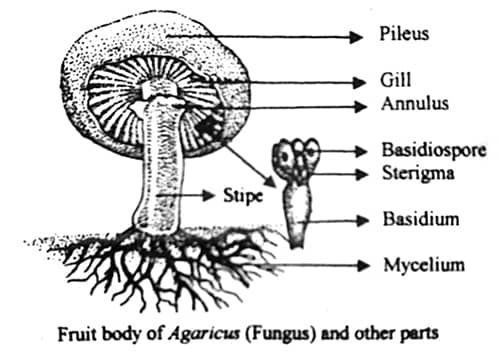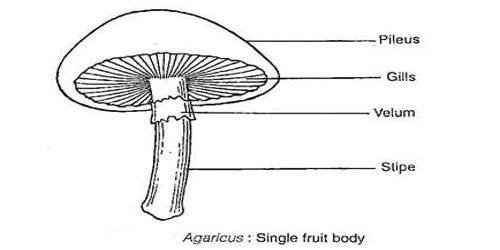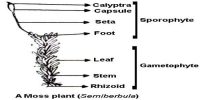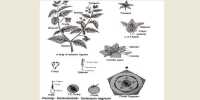Systematic position in plant classification: Agaricus is a fungus of the phylum-Basidiomycota under the class- Basidiomycetes. It is commonly known as mushroom.
Habitat:
(i) Grows as a saprophyte in decaying organic substances, such as cow dung, crop field, tree trunk, a heap of hays, etc. It is a saprophytic fungus found growing on soil humus, decaying litter on forest floors, in the fields and lawns, wood logs and manure piles.
(ii) Few species of Agaricus can also live in other organisms as parasites.
(iii) It grows best in moist and shady places and is commonly seen during the rainy season. It is cosmopolitan in distribution.
Structure: A complete Agaricus can be divided into two parts
(I) The main body or Mycelium or Vegetative mycelium (living inside the soil)
(II) Fruiting body or basidiocarp (present above the soil and edible in young stage)

Mycelium: It consists of numerous white-colored hyphae of transverse partition walls.
- Primary Mycelium: It originates by the germination of uninucleate basidiospores carrying either ‘+’ or ‘-‘ strain. The cells are uninucleate i.e., monokaryotic.
- Secondary Mycelium: After fusion of the hyphae of two opposite strains, the nucleus from one hypha migrates to the other and later gives rise to the bi-nucleate secondary mycelium i.e., dikaryotic.
- Tertiary Mycelium: The fruiting body appears like an umbrella above ground. It is made up of dikaryotic hyphae. These hyphae are called tertiary mycelium.
Fruiting body: Fruiting body is related to reproduction and is situated erectly above the soil It consists of an umbrella-like pileus and a stem-like stipe.
There are some membranous substances hanging from the lower part of the pileus, known as Gills and a circular part situated at the tip of the stipe called Annulus.
Nutrition: They Meet their nutrition demand by absorbing decaying organic substances.
Reproduction: Usually it reproduces by Sexual method.
(a) Vegetative Reproduction: It reproduces vegetatively by its perennating mycelium. The mass of spawn divides artificially into small blocks that are grown in soil supplemented with organic manure to obtain fruit bodies.
(b) Sexual Reproduction: Sex organs are absent in Agaricus and sexual reproduction takes place by somatogamy. Sexual reproduction is mainly somatogamous or pseudogamous. The sex organs are completely absent and their function has been taken over by the somatic hyphae which are heterothallic.
(c) Asexual Reproduction: Terminal or intercalary chlamydospores are developed on dikaryotic mycelium, which on germination during favorable condition produce dikaryotic mycelium.
Economic importance: By the name mushroom, it is used as delicious food in different countries of the World h is cultivated in different countries, including Bangladesh and sold in the market in both fresh and preserved forms.














